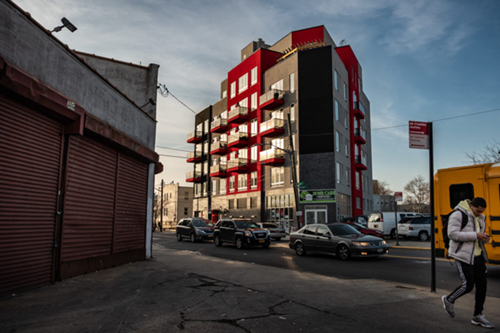CityLimits.org | December 23, 2020
‘The fact is that MIH is just bad policy. In New York City’s housing market, it mostly enriches developers and real estate speculators while inflicting real harm to the neighborhoods it’s supposed to help.‘
It is time to end Mayor Bill de Blasio’s policy of trying to build “affordable” housing via his signature Mandatory Inclusionary Housing (MIH) program. The next administration and current mayoral candidates should develop alternatives.
The fact is that MIH is just bad policy. In New York City’s housing market, it mostly enriches developers and real estate speculators while inflicting real harm to the neighborhoods it’s supposed to help. Here’s how it works: the city upzones someone’s property (or sometimes an entire neighborhood) in order to “incentivize” the demolition of what is already there and replace it with one or more out-of-scale tower(s). Up to 30 percent of the new apartments will be arguably “affordable”—occasionally to households earning 130 percent of the Area Median Income (AMI), about $133,000 a year for a family of three)—and the other 70 percent will be rented or sold to the world’s gentry as “market rate” units.

975 Liberty Ave, Brooklyn, one building shaped by the MIH program.
Fans of this approach say the rich will move into the new market-rate units, causing a price drop on their old apartments. They call that “filtering” which is pretty much a fairytale in New York City given how globalized real estate investment is. Proponents also argue that flooding the city with luxury housing will eventually lower the rent at the bottom of the market. That’s called the “trickle-down effect” which also doesn’t work in New York City’s market conditions. Advocates of this theory, such as OpenNY—even Deputy Mayor Vicki Been—also seek to use MIH and zoning to undercut New York’s historic districts and find illogical excuses to build over historic areas with towers, as they are now proposing for three sites in SoHo and NoHo (see the city’s Where We Live report, page 194), a move designed to benefit Edison Properties and Trinity Real Estate, not the citizens of New York.
So what could go wrong with MIH in New York City? Pretty much everything. Here’s a partial list:
- The MIH policy doesn’t work. As of December 2019, only 2,000 “affordable” units of the promised 80,000 have actually been built under the policy. Surely that is a sign of failure.
- What MIH does do is flood upzoned neighborhoods with luxury housing, mostly in the form of towers, creating a kind of gentrification on steroids that displaces existing residents and the small businesses that served them.
- The policy was never wanted by the citizenry. It was rejected by more than 90 percent of community boards but railroaded through city government anyway. So what’s the point of our already embarrassing model of democracy-as-focus-group that community boards are supposed to be?
- The policy was sold to the public with two lies. The first is that the city needed to build as fast as possible to accommodate a crisis of “a million new New Yorkers.” Supposedly, our population was going to explode and we all had to suck in our stomachs and squeeze more bodies into the schools and subway cars. That turned out not to be true. We’ve had a net loss of people all along, even before COVID. The real idea was to compete with other Eastern Seaboard cities to attract hundreds of thousands of yuppie tax-paying college grads from across the country by building speculative luxury condos for them on the waterfront. Really! This lie has massively harmed the credibility of the technocrats running our city. The second lie was that the only way to get affordable housing was to juice the returns of private sector developers to supply a tiny bit of it. That’s just a right-wing, trickle-down, “Chicago School” version of economics getting passed off as a “progressive” housing policy.
- Because this policy is based on big-time private sector developers as the main players, the definition of “affordable” gets fuzzier and fuzzier until it means nothing. Supposedly “affordable” is linked to a percentage of the “area median income” (AMI), a metric that is so flawed it prices out most New Yorkers. If you want to see what goes wrong, try to find an “affordable” unit in one of the towers of the Atlantic Yards project. My conclusion is that we need to get out of the game of fighting over AMI on each and every project and thinking that a trivial AMI concession or even just fixing the AMI standard will render a towerized project palatable. We need a different game and one not anchored in real concessions to developers and fantasy theory about MIH.
- The proliferation of grossly out-of-scale new buildings drives up rents for all and renders neighborhoods that are victims of it unrecognizable. There’s data to support that. It also literally darkens the local streets and parks and stresses our already overburdened infrastructure of schools, parks, libraries, and subways. These non-market costs are incalculable, and not accounted for with any seriousness by the de Blasio administration in the depressingly pointless environmental review process.
- There is also the immense problem that there is no place to build in the historic core of the city without demolishing something. That’s because we are the densest city in the country and already overbuilt as of 1955 (according to Robert Moses no less). “Who cares?” say the developers and this administration. A cynic like myself can’t help but think developers will say anything to squeeze even more luxury housing in the core, simply because the rates of return there are so high compared to building in the Bronx or Staten Island. They’ll use any justification, from affordable housing to incoherent racial integration theories to suburban notions about “transit-oriented development.” But the willful demolition of the historic core is literally killing off the very great urban neighborhoods that made people want to live in New York in the first place. Talk about short-term and blinkered thinking!
Are there less destructive alternatives? Of course there are, and especially if the city slows down and stops trying to do a “shock and awe” build-anything-now approach. Here are just six of the many ideas that have been floated, all of which would be an improvement and far less destructive to the city than reliance on floor area ratio (FAR) giveaways for MIH. Some of them have even been considered by the administration in a small-scale, hamfisted, or hesitant way, and always secondary to upzoning and MIH.
Idea 1: Create incentives for owners of single-family homes and rowhouses to create what is called an “auxiliary unit” or a “granny flat.” Done properly, this could create about 200,000 new housing units at the low end of the market, dispersed around the city. That is 100 times the number of units the MIH program has produced! Moreover, it benefits the middle class who own the houses, not the world’s real estate speculators. (Note we are not talking about the legalization issue of existing conversions which is also a fine, but limited idea).
Idea 2: Use the current downturn to buy up at cheap prices lots of existing apartment buildings that could go into a community housing trust. Vulture capital is already circling. Why shouldn’t the city win out on this one instead of Blackstone? Money might be interest free for this purpose.
Idea 3: Build six-story apartment buildings on three-quarters of Floyd Bennett Field. If you don’t know where that is, Google it. Hey, that’s more than 800 acres to work with. Yes, we’d have to get the land back from the feds, but is it any crazier than the speculative, incredibly costly projects proposed for Sunnyside Yards or Governors Island?
Idea 4: Build low (and mid-rise) in-fill housing on the excess open land and parking lots throughout the city’s publicly owned tower-in-the-park complexes. Do it very slowly, incrementally, as public money comes available. Don’t try to do this as a “shock and awe” strategy. Make it all 100 percent permanently affordable with just public money. Don’t go into debt for it. Don’t build over playgrounds, and don’t make it high rise. Don’t go over six stories so it is cheap to build. Design it so it reconnects these complexes to the urban street. Don’t do this via the RAD privatization process and don’t try to make these new units also subsidize NYCHA rehab. There are ways to get money for this, just not all at once. Incrementalism needs to win out here. Note that zoning guru Michael Kwarlter proposed low-rise infill in these spaces years ago.
Idea 5: Incentivize the return of single room occupancy (SRO) and protect the category from gentrification. The attack on the SRO for 20 years reached a pinnacle during the Koch administration, causing the loss of 200,000 beds in his administration alone. We lost everything from middle class “hotels for women secretaries” to flophouses on the Bowery. That’s a big mistake that needs to be rectified, but slowly and incrementally.
Idea 6: Make construction of six-story buildings as-of-right on all the commercial corridors of the outer half of the city while also banning the production of any more single-family homes anywhere. Disallow the conversion of any property to a single-family home. That would mean forbidding future moguls from imitating Michael Bloomberg, who combined two townhouses into one mega-mansion.
See? There are lots of alternatives to the deeply-flawed version of MIH-with-upzoning that the mayor has pushed. Candidates looking for new ideas on housing should read Human-Scale NYC’s Affordable Housing white paper here. To be sure, technocrats and permanent government types will resist a new path, as they often don’t like change or admitting they are wrong. Some are also dependent on developers for revolving-door jobs, research funds, or campaign finance money. Change is hard, but it is time for our policy elite to take Churchill to heart when he said, “All men make mistakes, but only wise men learn from their mistakes.”

